Port Macquarie Pest Control 02 65845536 Email pmqpestcontrol@gmail.com
Cockroaches
There are 428 species of cockroach in Australia and a number of introduced species have become pests. The two most significant pest cockroaches are the German cockroach and the American cockroach.
Cockroaches live and feed in unhygienic places such as sewers and drains, or feed on garbage that may be contaminated. These insects are cold-blooded and thrive in warm, humid conditions. This is why buildings in the northern parts of Australia are particularly prone to infestations.
However cockroaches will make their home wherever they find food, moisture and shelter.
German
cockroach
The German cockroach is the most common cockroach found in houses and
apartments in Australia.
Their small size means that human occupants, many of whom do not recognize early
nymphal stages as cockroaches, initially tolerate them.
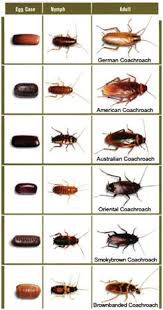
American
cockroach
The American cockroach is the largest of the pest species.
It is red-brown, with fully developed wings that cover the abdomen, and it will
fly in warm conditions. The American Cockroach has a great potential for
producing offspring.
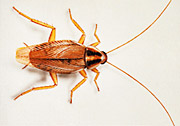
Their rapid reproduction rate enables a few individuals to become a pest problem over one season. From an original female German cockroach there could be potentially more than 100,000 cockroaches in a home by the end of one year!
German cockroaches are nocturnal and forage for food and
water at night when they are less likely to be seen. In the daytime, they hide
in cracks and crevices in cupboards and kitchen appliances and so are easily
overlooked. You can find them around refrigerators, dishwashers, stoves,
washers and dryers, and water heaters. They do not fly.
The German cockroach is the most difficult pest cockroach species to control.
A single brown-banded female cockroach has the potential to produce about 250 offspring. But, because of the longer time that it takes nymphs to grow into sexually mature adults, large populations are not produced as quickly as those of the German cockroach. In addition, because the egg cases are glued to objects in the environment soon after formation, they are susceptible to drying out, attack by fungi and other factors that contribute to produce a low hatch rate
Because of the large size of both adults and nymphs, people
are less tolerant of this species, and the cockroaches also find fewer places
inside to hide in the daytime. When established in homes they are normally
found in wall voids or behind cupboards, in underfloor areas or in roof spaces.
Normally they enter living rooms, kitchens and bathrooms when they are foraging
for food and water. They are most associated with the areas around homes or
buildings. Common areas where they are found include gardens, around garbage,
inside drains and in outhouses such as sheds or garages.
American cockroaches can coexist with German Cockroaches with no negative
effects on either cockroach population.
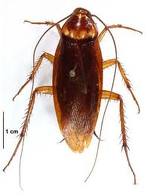
The oriental cockroach
found in the cooler areas of Australia. They are dark brown or black and may be found under floors, in sewers and drains, and around garden rubbish.
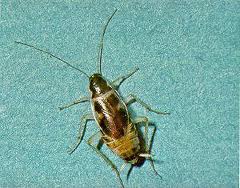
This translates into a much lower potential for
offspring production than for the German cockroach.
They are often found dispersed through the house behind picture frames and in
light switches and furniture. Because they require less water than German cockroaches,
they often survive in drier locations that are unsuitable for German
cockroaches. They frequently occur in locations at eye-level or above such as
in cabinets, around closet shelves, behind pictures, in warm areas near motors
of refrigerators, electric clocks, timers and television sets. Other favourite
habitats are around the braces of kitchen chairs and tables, around objects on
the wall and in showers.
Economic and health impacts of
cockroaches
Cockroaches are a health hazard. They carry bacteria on their bodies from
sewers, drains and garbage areas and then transmit it to you and your family by
visiting your kitchen and bathroom areas. Feeding in such areas as sewers,
drains and garbage areas brings them in contact with disease organisms
including salmonella and other organisms associated with dysentery, typhoid,
hepatitis and tuberculosis.
Ingested bacteria can survive in the cockroach's digestive system, sometimes for months or even years, and are passed in its droppings. It is thought that disease is then transmitted to humans when they eat cockroach droppings on contaminated food.
Cockroach allergies and
asthma
People can become allergic to cockroaches and their
faeces. This allergic reaction is a worldwide phenomenon, with sensitivity to
cockroaches ranging from 23–60% of the population tested. Cockroach allergens
are present mostly in settled dust, rather than air, as the particles are large
and do not remain airborne unless disturbed. There seems to be a particular
association between cockroach allergens and asthma but they can also cause
rhinitis and dermatitis. The allergens are potent sensitisers of children and
exposure to cockroach allergens early in life has been found to be a predictor
for the development of asthma.
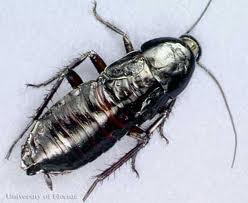
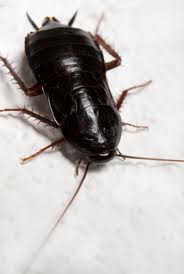
A single female oriental cockroach has a much lower potential for producing offspring than either the German or the brown-banded females.